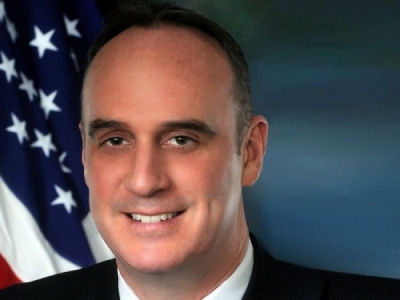
Posted on July 23, 2020
DredgeWire Exclusive
On June 9, 2020, Maryland Governor Larry Hogan announced the appointment of William P. Doyle, Chief Executive Officer of the Dredging Contractors of America, (DCA) as the new Head of the Maryland Port Administration and Executive Director of the Port of Baltimore. Mr. Doyle agreed to an exclusive interview with DredgeWire during his last week on the job with the DCA.
Looking back now, after 2 ½ years on the job as Chief Executive Officer for the Dredging Contractors of America, what do you think of the industry?
I have all the respect in the world for the U.S. dredging industry. Each company is different – each company has its own corporate personality – each company is filled with personalities – and each company is ultra-competitive. The dredging companies are true innovators, entrepreneurs and staffed with hard working, get-the-job-done,people. I learned so much in this job by listening and learning to what the dredgers did and said. And they backed it up—by performance. Their projects over the past 2-1/2 years for the most part were completed on time or ahead of schedule. They made it look easy: all I had to do was announce their successes. More importantly, the U.S. dredging companies are spending hundreds of millions of dollars—billions really, building new dredges and support vessels, buying new equipment, and retrofitting other machinery. They answer the call day in and day out.
You had a lot of activity on Capitol Hill. Talk about that if you would.
This administration and Congress have been incredibly supportive of the dredging industry. They all get it. Post Panama Canal expansion, we now have ships three times the size of what cranes and berths and channels at East Coast and Gulf Coast ports could handle before the expansion in 2016. This means ports, harbors and waterways must be dredged deeper and wider. We’ve also seen some gale force weather patterns hit our beaches, coastal waterways, and rivers causing erosion, extra siltation, and beach sand loss.
At the DCA we’ve worked extremely hard over the past couple of years advocating for funding. We’ve been successful. In the FY-19, FY-20 –Congress has appropriated $2 Billion for harbor maintenance dredging, deepening, widening, coastal restoration and beach nourishment.
This year, under the CARES Act, Congress finally moved the Harbor Maintenance Trust Fund (HMTF) off-budget. The dredging industry has been working with congressional leaders for two decades on the HMTF off-budget proposal. We’ve also maintained that full utilization of the HMTF for its intended purpose, that is, harbor maintenance dredging, was a primary goal for the industry.
You worked well with the U.S. Army Corps of Engineers leadership; can you explain?
It really is a public-private partnership. I came into this job not knowing much about the navigation side of USACE. I had to sprint from day one to catch up and learn about the dredging side. I spent a lot of time working with the leadership at USACE, trying to figure out what they needed to accomplish and how we in the dredging industry could help them accomplish their mission.
Our biggest hurdle, as I found out, was the Southwest Pass (Lower Mississippi River, “SWP”) and the annual flood – which usually occurred between January and April every year. The dredging industry and the Corps had been doing things the same way for the past few decades meaning: wait for the flood, then call out to private industry to see if any dredgers were available, and, eventually, pull vessels off other projects in other states as well as break out the ready-reserve fleet of government-owned and operated dredges. It just seemed inefficient to do the same things repeatedly and expect a different result. We had at least to try something different.
The DCA companies and USACE leadership sprang into action and held a series of high-level meetings and partnering summits both in DC and in the Gulf.We hashed out ideas and discussed ways that things could be done differently. We determined, together, that having USACE contract early for private sector hopper dredges before the flood season began might be a better way to schedule and plan dredge capacity. First, it would provide the Corps with certainty that dedicated private sector hopper dredges would be available during the flood season. Second, the private sector dredging companies could schedule and plan all their harbor maintenance, beach, and coastal restoration work around the SWP, at least as it applies to the dredges, and they could decide in advance which dredges they would dedicate to the SWP flood season.
As it stands now, we have three dedicated hopper dredges that are contracted and ready for action when the SWP 2021 flood season begins—something that has never been tried before.
Developing this program was not easy. It required a transformational change in thinking within the Corps and within the private sector dredging industry. I really want to thank LT General Todd Semonite, USACE Chief of Engineers and Major General Scott Spellmon for their dedication to working with private industry to find solutions that help foster the public-private partnership, while at the same time advancing ways to improve carrying out the mission. Without their buy-in and help, nothing would have changed. Finally, from a daily, hands on, mission focused perspective I want to thank Tom Smith, USACE Chief, Operations and Regulatory LRD/NAD Regional Integration. We talked often and listened to each other more than we talked. I don’t think there was a problem we could not solve or find a path forward on.
Coming next Tuesday, July 28, Part II of Bill’s Exclusive interview with DredgeWire where he talks about new building programs, National Security and more…..





